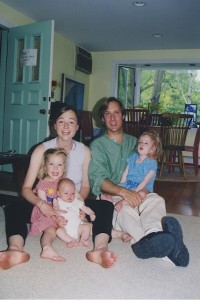11/20/2014
·Enable high contrast reading
Our daughter's story was in our hands.

“The world was broken and the three of us were falling into its mouth.” – The Still Point of the Turning Word, Emily Rapp
I love this quote because it captures so perfectly the experience parents have when their child is diagnosed with a rare and life-threatening illness. I fell through the world when my daughter Cameron was diagnosed at age 6 months with infantile Tay-Sachs disease, a genetic disease that affects the central nervous system and for which there is still no treatment or cure. Tay-Sachs is progressive and always fatal. My daughter died at the age of 2.
My family spent the first few months reviewing the ongoing research to see if there was any hope for treatment. We talked to scientists in New York, Massachusetts, and California, but there was nothing hopeful for our daughter. So where was the hope going to come from? We did have each other and an amazing extended family and an older daughter who was 2 at the time. But these people knew nothing about disease and couldn’t help us navigate the scary road of choices and care that lay ahead. We felt vulnerable and exposed and afraid that we might make a mess of things and be riddled with regret. We had one job to do for our daughter: to give her the best life she could have, for as long as she could have. Who was going to help us do that?
The help came from our daughter’s pediatrician who practiced palliative care and ushered us slowly into the framework of thinking and decision-making that is central to palliative care work. He asked us what our goals of care were for Cameron and what level of invasive treatments we would tolerate for her. He helped us
- — Find a child psychologist with whom we could talk about how to explain things to our older daughter
- — Manage Cameron’s grand mal seizures at home, by ourselves, so we could keep her out of the hospital
- — Find a pain specialist with whom we could talk about managing Cameron’s possible discomfort towards her end of life
- — Complete the DNR form in the event we would need it
He didn’t do this all at once of course. There wasn’t just the “one” conversation; there were multiple ones that happened over the course of Cameron’s life and the disease trajectory. Most rare diseases move slowly enough that parents and those patients who are cognitively capable have the “gift of time” to think things through before the crises break. Indeed, one of the most reassuring things he told us after delivering Cameron’s diagnosis was, “You don’t have to figure this out all at once. Go home, and when you’re ready, we’ll start talking about what Cameron will need and how we can help meet these needs.” Under his care, we experienced how palliative medicine is precisely about making use of time to anticipate needs and make thoughtful decisions with the information at hand. Even then, we never felt our agency as parents was being hijacked by the medical machine.
Reflecting back on our daughter’s time with us, we can say that we gave Cameron a full life, with a beginning, a middle, and a gentle end. We have very few regrets, and none of any impact. And this is perhaps the most important thing that palliative medicine offers: the empowerment and agency to say what is it you want for the patient’s care and life beyond the disease itself. We didn’t have to say YES to every intervention available. We didn’t have to surrender decision-making to the specialists. Our daughter Cameron’s story was in our hands, and we helped it be a good one, and that has made all of the difference.



